A lack of “red tape” in Australian agriculture encouraged Irish farmer Brian Corr to buy his own farm in Victoria.
Corr, who first left Co Monaghan almost 15 years ago, said that in comparison to Ireland, there is a “total lack of regulation” for farmers down under.
“It’s very easy to set up a farm and farm without red tape and hassle from anyone,” he explained.
“I’m not saying that we’d be doing things wrong that would be harmful for the environment, but there are definitely less hoops to jump through.”
The Newbliss native hails from a poultry and dairy farm and said he would never have been able to buy up land and grow his business to the same extent if he hadn’t come to Australia.
Corr graduated from Ballyhaise Agricultural College in 2004 with a degree in dairy husbandry and production.
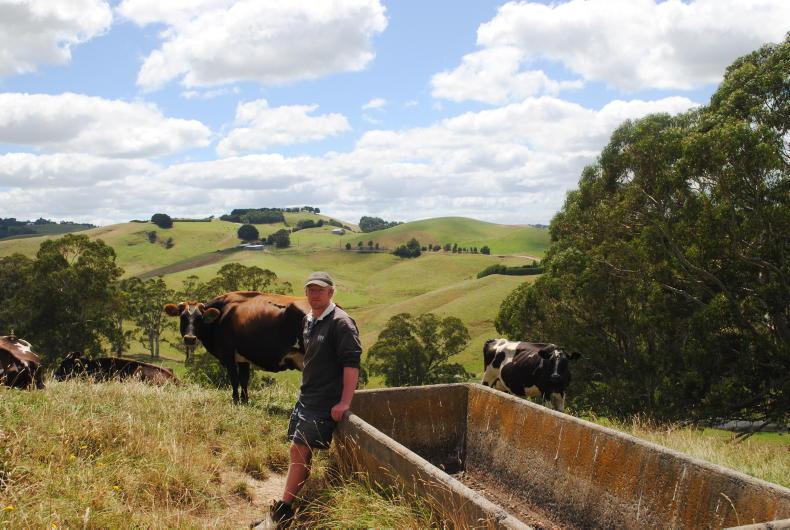
Brian graduated from Ballyhaise in 2004. \ Barry Murphy
He bought his 383ac farm in Moyarra, Gippsland, in 2022 and leases a further 210ac. He previously managed farms nearby.
The area is a mix of prime pasture and hill land, about an hour and half outside of Melbourne.
The farm is plotted with mature and recently planted trees and hedgerows.
Alongside his partner, Myrid, Corr is currently milking 500 crossbred cows with plans to reach 600 head and produce 200,000kg of milk solids annually by next year.
He highlighted that in comparison to his new farm, dairy farmers in Ireland are facing ever-stricter environmental regulations.
He said the European Union’s nitrates derogation cut makes farming at home far less attractive.
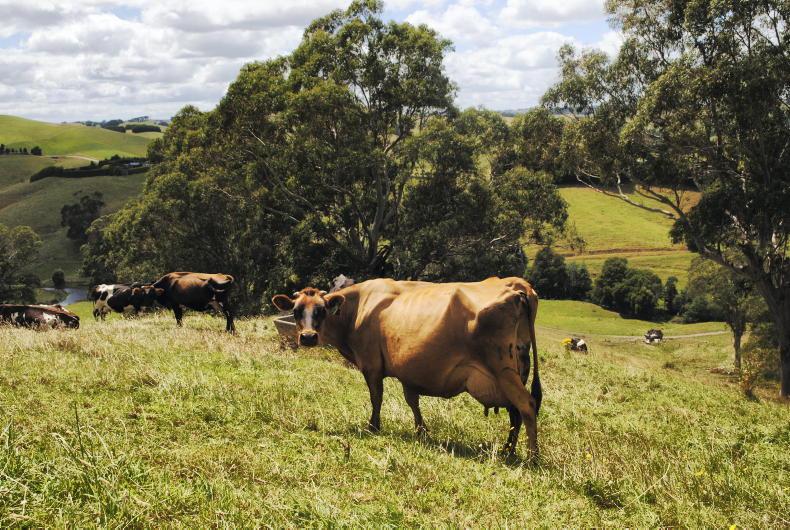
The majority of the herd calves between September and November. \ Barry Murphy
Land availability
Another factor that encouraged Corr to settle in Australia was the greater availability of land.
He bought his farm at €6,000/ac and has plans to expand over the next five years.
“For us to be able to buy over 300ac and expand with leasing, it wouldn’t be possible at home as there’s so much competition,” he said.
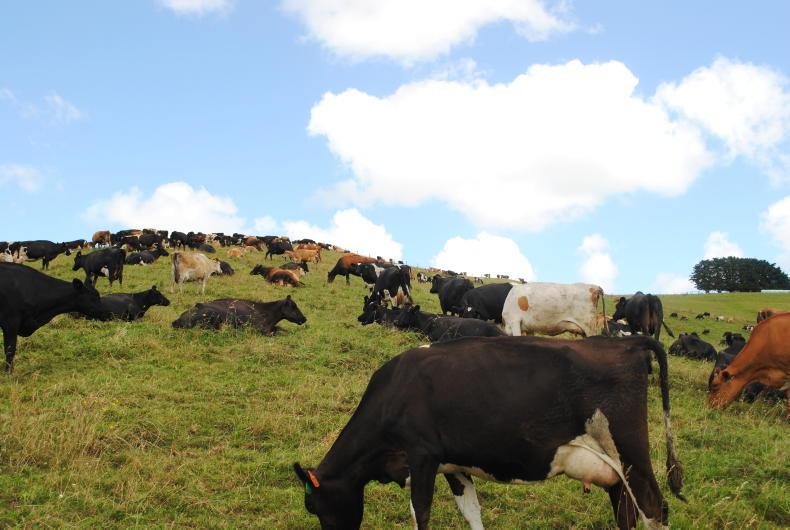
All cows are bred to Friesian and Jersey sires. \ Barry Murphy
He also pointed out that due to Victoria’s climate, there is less need for high-cost infrastructure investment on dairy farms there.
“You don’t have to build infrastructure or housing for animals,” he said.
He described how other than his 30-unit herringbone milking parlour and calf shed, his farm requires little more than electric fencing and water troughs.
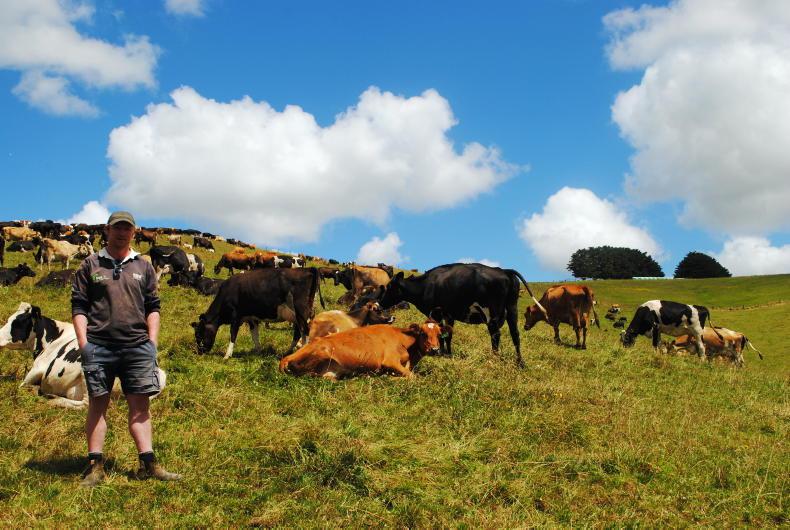
The herd calves outdoors with calves drying in the sunshine and up and going quickly.\ Barry Murphy
This compares to Irish dairy farmers’ investment in concrete and steel – slurry storage and sheds.
Milk prices
Corr insisted that unlike farming in Ireland, there is greater opportunity for farmers in Australia to make a viable and sustainable income.
He highlighted that milk prices for Victorian farmers are “locked in” at the start of the milking season (1 July) where prices can’t drop below the set price, but can increase.
This, he explained, enables long-term planning for the farm unlike in Ireland, where milk price is set monthly by processors.
He said Australian dairy farmers can also change the processors they supply to each year.
This is not the case in Ireland, where longer-term supply contracts are the norm.
However, the Gippsland farmer said that, on average, he receives a milk price of 46c/l for milk solids, and that after conversion to the euro, this is about the same as the price received at home.
System
The majority (95%) of Corr’s herd calves during the Australian spring (September to November) with the remainder calving in autumn (March to May).
As he is building cow numbers, he has not yet tightened his calving period but plans to hit a solely spring-calving target within the next year.
He explained that it isn’t feasible to cull later-calving cows and buy new heifers when the former are trading at €200 to €250 per head and the latter would cost him almost €1,000.
The herd calves outdoors with calves drying in the sunshine and up and going quickly.
AI is used for the first six weeks of breeding with “clean-up” bulls used for three weeks thereafter.
All cows are bred to Friesian and Jersey sires and the farm’s ideal cow is on the smaller side with a bit of depth to her.
All heifers are bred to Jersey bulls.
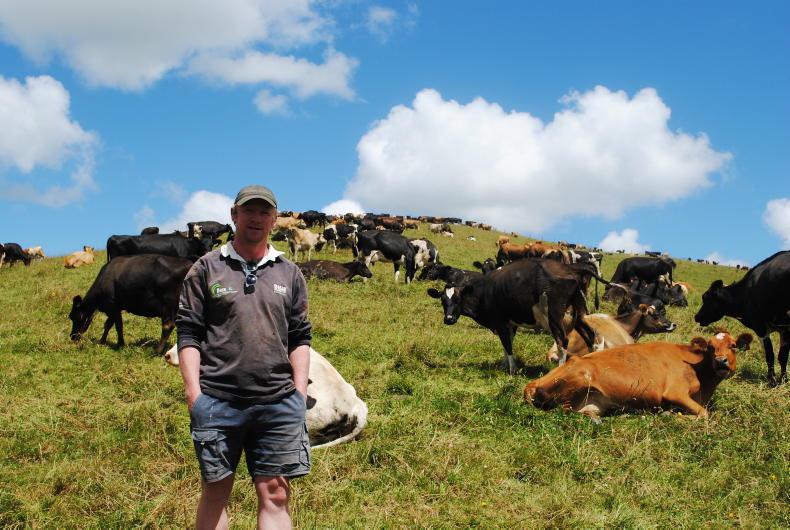
Brian emigrated to Australia 15 years ago. \ Barry Murphy
Pasture-based farming:
advantage for Irish in Australia
Another advantage Irish farmers who relocate to Australia have is their expertise and education in pasture-based farming, Corr suggested.
He said that while some Australian farmers are catching on to the benefits of well-managed grazing platforms, others remain focused on grain and feed intake, in contrast to his Ballyhaise training.
The dairy farmer said that his farm is a “very low-input system for dairy in Australia”.
Dry spell
He has planted several fields with chicory and said it works well when the farm gets a dry spell in summer.
With well-managed paddocks, Corr plans to feed just 800kg of wheat per cow this year, at a cost of €250/t.
Cheaper
He said this is about €60/t cheaper than dairy pellets.
On farm labour, he said: “If there are locals available, we certainly give them a chance” but that he always looks out for the Irish.
“There’s a lack of skills here for pasture systems. They have no real understanding. Some of that is down to the fact that you can buy grain cheap here,” he said.
“The next time we’re looking for someone full-time, we’ll probably see if we can pinch them from Ireland.
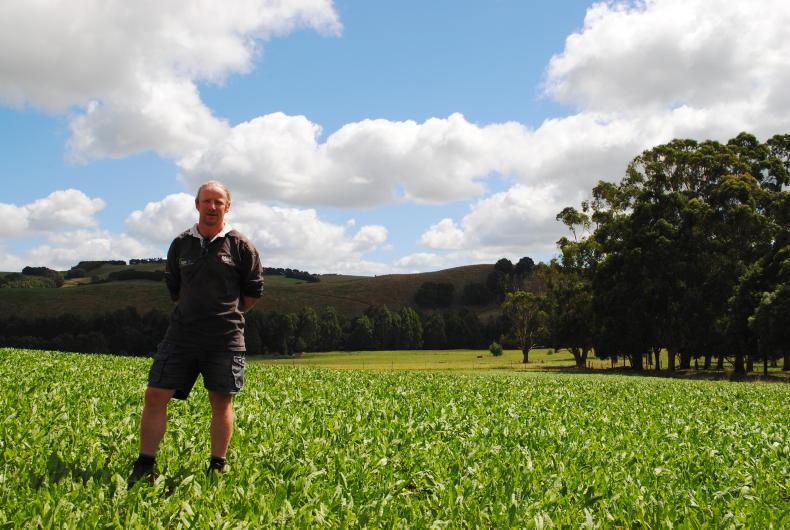
Brian Corr plans to settle in Victoria in the long term. \ Barry Murphy
“They know why you’re trying to push for pasture,” he said.
The Irish man making Australia home said he plans to settle in Victoria in the long term and continue striving for further farm improvement.
Brian Corr from Newbliss, Co Monaghan.Graduated from Ballyhaise Agricultural College in 2004.Emigrated to Australia 15 years ago.Bought a 383ac farm in Gippsland, Victoria, in 2022 at €6,000/ac.Leasing a further 210ac.Milking 500 cows for 2024, aims to milk 600 by 2025 and produce 200,000kg milk solids.
A lack of “red tape” in Australian agriculture encouraged Irish farmer Brian Corr to buy his own farm in Victoria.
Corr, who first left Co Monaghan almost 15 years ago, said that in comparison to Ireland, there is a “total lack of regulation” for farmers down under.
“It’s very easy to set up a farm and farm without red tape and hassle from anyone,” he explained.
“I’m not saying that we’d be doing things wrong that would be harmful for the environment, but there are definitely less hoops to jump through.”
The Newbliss native hails from a poultry and dairy farm and said he would never have been able to buy up land and grow his business to the same extent if he hadn’t come to Australia.
Corr graduated from Ballyhaise Agricultural College in 2004 with a degree in dairy husbandry and production.

Brian graduated from Ballyhaise in 2004. \ Barry Murphy
He bought his 383ac farm in Moyarra, Gippsland, in 2022 and leases a further 210ac. He previously managed farms nearby.
The area is a mix of prime pasture and hill land, about an hour and half outside of Melbourne.
The farm is plotted with mature and recently planted trees and hedgerows.
Alongside his partner, Myrid, Corr is currently milking 500 crossbred cows with plans to reach 600 head and produce 200,000kg of milk solids annually by next year.
He highlighted that in comparison to his new farm, dairy farmers in Ireland are facing ever-stricter environmental regulations.
He said the European Union’s nitrates derogation cut makes farming at home far less attractive.

The majority of the herd calves between September and November. \ Barry Murphy
Land availability
Another factor that encouraged Corr to settle in Australia was the greater availability of land.
He bought his farm at €6,000/ac and has plans to expand over the next five years.
“For us to be able to buy over 300ac and expand with leasing, it wouldn’t be possible at home as there’s so much competition,” he said.

All cows are bred to Friesian and Jersey sires. \ Barry Murphy
He also pointed out that due to Victoria’s climate, there is less need for high-cost infrastructure investment on dairy farms there.
“You don’t have to build infrastructure or housing for animals,” he said.
He described how other than his 30-unit herringbone milking parlour and calf shed, his farm requires little more than electric fencing and water troughs.

The herd calves outdoors with calves drying in the sunshine and up and going quickly.\ Barry Murphy
This compares to Irish dairy farmers’ investment in concrete and steel – slurry storage and sheds.
Milk prices
Corr insisted that unlike farming in Ireland, there is greater opportunity for farmers in Australia to make a viable and sustainable income.
He highlighted that milk prices for Victorian farmers are “locked in” at the start of the milking season (1 July) where prices can’t drop below the set price, but can increase.
This, he explained, enables long-term planning for the farm unlike in Ireland, where milk price is set monthly by processors.
He said Australian dairy farmers can also change the processors they supply to each year.
This is not the case in Ireland, where longer-term supply contracts are the norm.
However, the Gippsland farmer said that, on average, he receives a milk price of 46c/l for milk solids, and that after conversion to the euro, this is about the same as the price received at home.
System
The majority (95%) of Corr’s herd calves during the Australian spring (September to November) with the remainder calving in autumn (March to May).
As he is building cow numbers, he has not yet tightened his calving period but plans to hit a solely spring-calving target within the next year.
He explained that it isn’t feasible to cull later-calving cows and buy new heifers when the former are trading at €200 to €250 per head and the latter would cost him almost €1,000.
The herd calves outdoors with calves drying in the sunshine and up and going quickly.
AI is used for the first six weeks of breeding with “clean-up” bulls used for three weeks thereafter.
All cows are bred to Friesian and Jersey sires and the farm’s ideal cow is on the smaller side with a bit of depth to her.
All heifers are bred to Jersey bulls.

Brian emigrated to Australia 15 years ago. \ Barry Murphy
Pasture-based farming:
advantage for Irish in Australia
Another advantage Irish farmers who relocate to Australia have is their expertise and education in pasture-based farming, Corr suggested.
He said that while some Australian farmers are catching on to the benefits of well-managed grazing platforms, others remain focused on grain and feed intake, in contrast to his Ballyhaise training.
The dairy farmer said that his farm is a “very low-input system for dairy in Australia”.
Dry spell
He has planted several fields with chicory and said it works well when the farm gets a dry spell in summer.
With well-managed paddocks, Corr plans to feed just 800kg of wheat per cow this year, at a cost of €250/t.
Cheaper
He said this is about €60/t cheaper than dairy pellets.
On farm labour, he said: “If there are locals available, we certainly give them a chance” but that he always looks out for the Irish.
“There’s a lack of skills here for pasture systems. They have no real understanding. Some of that is down to the fact that you can buy grain cheap here,” he said.
“The next time we’re looking for someone full-time, we’ll probably see if we can pinch them from Ireland.

Brian Corr plans to settle in Victoria in the long term. \ Barry Murphy
“They know why you’re trying to push for pasture,” he said.
The Irish man making Australia home said he plans to settle in Victoria in the long term and continue striving for further farm improvement.
Brian Corr from Newbliss, Co Monaghan.Graduated from Ballyhaise Agricultural College in 2004.Emigrated to Australia 15 years ago.Bought a 383ac farm in Gippsland, Victoria, in 2022 at €6,000/ac.Leasing a further 210ac.Milking 500 cows for 2024, aims to milk 600 by 2025 and produce 200,000kg milk solids. 










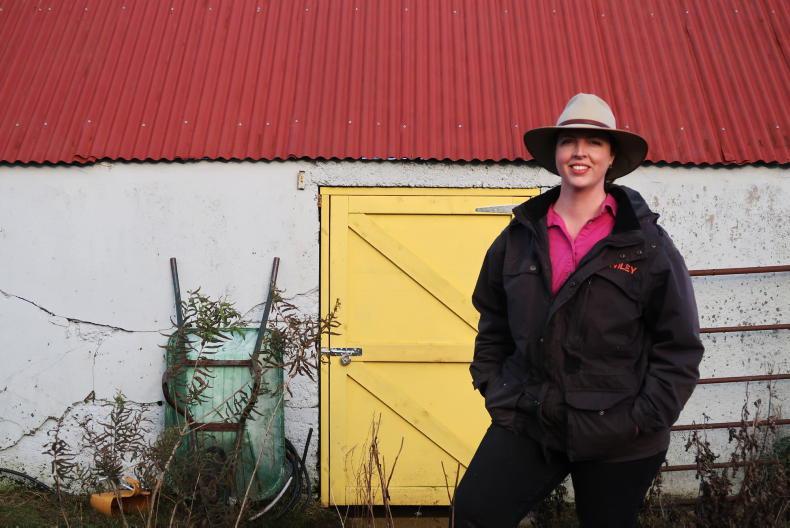
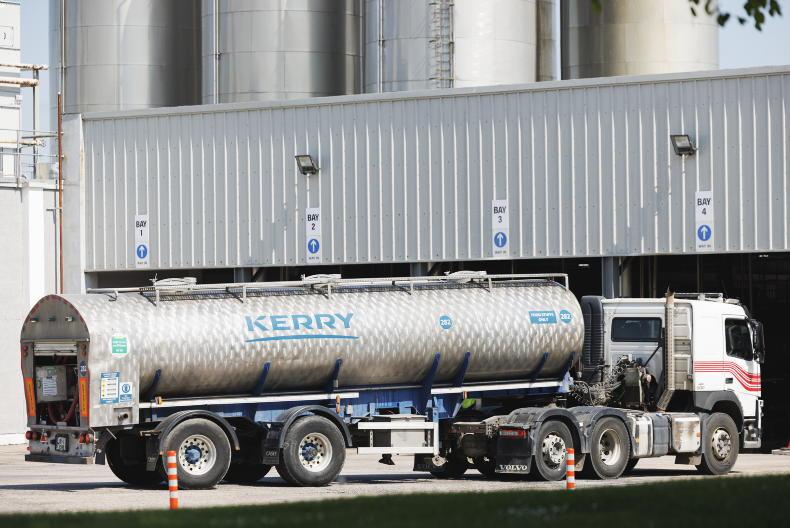


SHARING OPTIONS